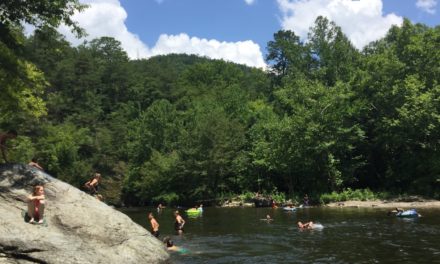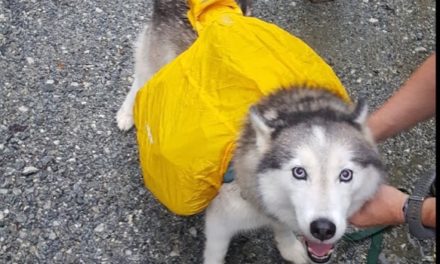The Thames was tumultuous yesterday. An authentic day of English storms chopped the waters. We boarded a tour bus that was summarily attacked by a nearby cargo truck, severing the mirror from its front right shoulder. Blinded, the driver could not soldier on, so we had to overtake another bus. We circled London–Hyde Park to Buckingham to Westminster to St. Paul–in the open air of a bus with the rain pelting us on and off, got stopped in a slough of traffic, and disembarked. Somewhat cold, we rallied in Starbucks for warmth and wifi and then our way into Kennsington. The pub we had sought didn’t open their kitchen until 5, which left us a bit hangry and miserable. So we re-traced our steps to Byron, a place for “proper hamburger” (that we later discovered had been in the news for other reasons). https://youtu.be/Hqazd86qjlk
Finally, we found solace in the basement of Waterstone’s, a London bookstore chain. Nic found teacher materials that she gushed over, and I, too, found a couple unique British publications. Claire Fox’s I Find That Offensive has been in my backpack for a Tube read ever since; it chronicles the struggle we have between voicing ideas freely and limiting that speech in the name of safety. Finally, the highlight of the evening…the Valders met us and we trekked down to the Scarsdale Pub for beers and food.

Today, the Thames is much calmer, and the sun is playing peek-a-boo with the grey. We made our way over to the Westminster Wharf to catch a tour of the city by river. The river gently nudged us past the London Eye, the Tate, the New Globe, underneath the bridges. On the port side, we even passed the school where–as a boy–young Winston Churchill was expelled for fighting. On our starboard side (right for you land-lubbers), we passed the warships of two former enemies–England and Japan–waving convivially in the water while on our boat, two families jostled for supremacy of selfie position as we approached the Tower Bridge.
Back on the banks, Nic and I scored a picnic lunch from Paul’s French Deli and found a bench in front of the Tower of London. It was our earliest lunch of the week; maybe we’re finally getting used to this time zone. Tourists of all nationalities strolled over the uneven stone as we ate in the shade of ancient battlements long since become a museum. We watched the Tower Bridge raised as two English tug boats guided the Japanese warship out of harbor on its way out to sea and back home.

Lunch finished, we entered the Tower. The girl at the gift shop had recommended we take the Yeoman’s tour. Upon entering the gate, we turned left to a meadow that was once the moat of the palace. We descended into the moat and awaited the start.


The Yeoman–for us Yanks–is the guy on a bottle of Beefeaters Gin, and they unofficially trace their lineage to a battle when Prince Henry VII of Wales defeated Richard I and brought all is homies to be his personal guard at court. Our Yeoman insisted that we were not to refer to him as a tour guide, as he is an official, highly elite member of the Queen’s Guard. That said, he was also an amazing “tour guide.”
The Yeoman roused the crowd to cheer for the Empire, then gave the crowd what they came for: stories of cruel executions, war, and torture–like the process of public execution through decapitation, which leads to the preservation of the head with tar and cumin for public edification; like the bungled execution of James Scott, whose head was finally removed by a butcher knife but had to be re-attached so that his royal portrait could be painted; like the execution of Henry VIII’s wives–including Anne Boylen, whose severed head allegedly looked around and continued to mouth the prayers she was saying as the axe fell.
Yes, this fascinating part of the tour took a tour for the gory, but we next found ourselves in line for the Crown Jewels. And while the stones are impressive–and they are stunning–I was more taken aback by the extravagant opulence of the tableware for the coronation dinner. Here, I imagined the king and his family feasting, swilling wine in tankards of gold taken from a golden punch bowl a meter wide. The excess of jewelry seemed almost paltry compared to the excess made for ONE meal for the monarch.
Across the courtyard, we entered the White Tower–now a repository for the history of armor and weapons. The daunting suits of armor for royals AND their horses reminded of a time when political power was more intimately tied to personal wealth and violence, and leaders were more intimately involved in the martial struggles of their nations. Included in the collection were a vast array of weaponry to display the many ways people have been killed over the years.


A few days ago, we viewed a rich cultural heritage of music, literature, politics, religion, science, and art–all embodied in the written word–and I was overwhelmed with its beauty. But this, too, is our cultural heritage. Human history has been shaped by struggle, domination, and conquest just as much as it has by those beautiful pursuits of ingenious wonder. We often forget that our modern nations are rooted in these histories, and that political power often originates in wealth and physicality and enforces itself with violence. Mao once said, “political power originates in the barrel of a gun.” It seems that throughout history, insert the weapon of choice and this is still true. Perhaps in the more modern world, we like to believe we have evolved past this point. But walking through those ancient halls made me feel that we believe in that fantasy at our peril.



For all the war memorial’s America has, Britain has us in spades. You can’t throw a rock in this country and you’ll hit a statue of a war hero. It’s a country that defines its history through battles great and small, and that the sun never set on the British Empire. From the Tower we wandered a bit aimlessly across town, trying to find the Kubrick exhibit that had already closed. We passed under the Australia House, one of several former colonies once under and still identified by the Union Jack. By sunset, we had reached Trafalgar Square-named after a famous Napoleonic battle. There, a classical guitarist busked “The Great Gate of Kiev” from Pictures at an Exhibition. We were entranced, and the edge caused by my reflection on humankind’s militaristic tendencies began to melt into the twilight.

 Tranquility had seemed to descend on the world as we wandered into the night. At the banquet hall, we met a security guy who chatted NFL with us for a good ten minutes, and then we found what we had stayed so late for. Nicole had wanted to take night pics of Parliment, so we made our way down the bridge, working multiple angles as people of various nationalities and languages laughed and sang and pedaled and kissed all along the bridge. On the other side, Nic gave a French guy an impromptu lesson to improve his night shooting as the current seats of political power lay silent accross the Thames. Back across the bridge, sirens of police and ambulance passed by, but we were sleepily on our way home. Nicole helped another photographer, and then on to another Tube ride back to Ealing for a night of peaceful sleep. Good night, London.
Tranquility had seemed to descend on the world as we wandered into the night. At the banquet hall, we met a security guy who chatted NFL with us for a good ten minutes, and then we found what we had stayed so late for. Nicole had wanted to take night pics of Parliment, so we made our way down the bridge, working multiple angles as people of various nationalities and languages laughed and sang and pedaled and kissed all along the bridge. On the other side, Nic gave a French guy an impromptu lesson to improve his night shooting as the current seats of political power lay silent accross the Thames. Back across the bridge, sirens of police and ambulance passed by, but we were sleepily on our way home. Nicole helped another photographer, and then on to another Tube ride back to Ealing for a night of peaceful sleep. Good night, London.




Recent Comments